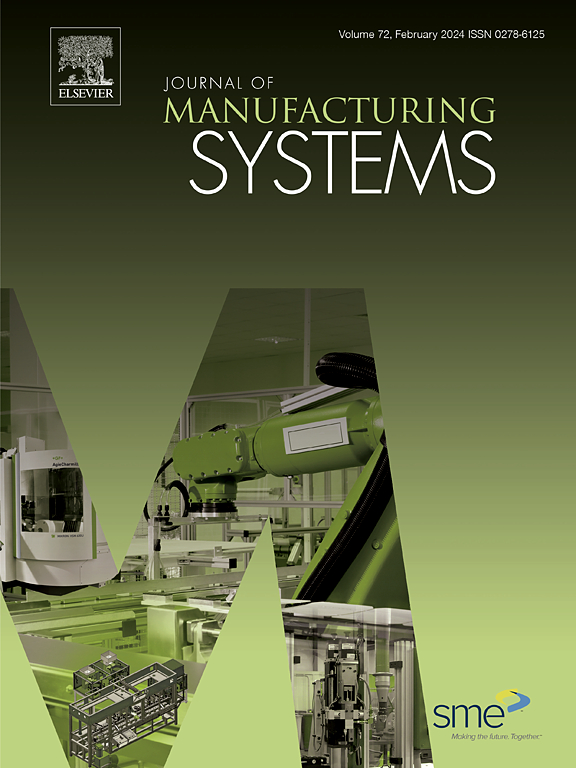Real-time decision-making for Digital Twin in additive manufacturing with Model Predictive Control using time-series deep neural networks
IF 14.2
1区 工程技术
Q1 ENGINEERING, INDUSTRIAL
引用次数: 0
Abstract
Digital Twin – a virtual replica of a physical system enabling real-time monitoring, model updating, prediction, and decision-making – combined with recent advances in machine learning, offers new opportunities for proactive control strategies in autonomous manufacturing. However, achieving real-time decision-making with Digital Twins requires efficient optimization driven by accurate predictions of highly nonlinear manufacturing systems. This paper presents a simultaneous multi-step Model Predictive Control (MPC) framework for real-time decision-making, using a multivariate deep neural network, named Time-Series Dense Encoder (TiDE), as the surrogate model. Unlike conventional MPC models which only provide one-step ahead prediction, TiDE is capable of predicting future states within the prediction horizon in one shot (multi-step), significantly accelerating the MPC. Using Directed Energy Deposition (DED) additive manufacturing as a case study, we demonstrate the effectiveness of the proposed MPC in achieving melt pool temperature tracking to ensure part quality, while reducing porosity defects by regulating laser power to maintain melt pool depth constraints. In this work, we first show that TiDE is capable of accurately predicting melt pool temperature and depth. Second, we demonstrate that the proposed MPC achieves precise temperature tracking while satisfying melt pool depth constraints within a targeted dilution range (10%–30%), reducing potential porosity defects. Compared to Proportional–Integral–Derivative (PID) controller, the MPC results in smoother and less fluctuating laser power profiles with competitive or superior melt pool temperature control performance. This demonstrates the MPC’s proactive control capabilities, leveraging time-series prediction and real-time optimization, positioning it as a powerful tool for future Digital Twin applications and real-time process optimization in manufacturing.

基于时间序列深度神经网络模型预测控制的增材制造数字孪生实时决策
数字孪生(Digital Twin)是物理系统的虚拟复制品,可实现实时监控、模型更新、预测和决策,结合机器学习的最新进展,为自主制造中的主动控制策略提供了新的机会。然而,通过数字孪生实现实时决策需要由高度非线性制造系统的准确预测驱动的有效优化。本文提出了一种实时决策的同步多步模型预测控制(MPC)框架,采用多变量深度神经网络时序密集编码器(TiDE)作为代理模型。与传统的MPC模型只能提前一步预测不同,TiDE能够一次(多步)预测预测范围内的未来状态,大大加快了MPC的速度。以定向能沉积(DED)增材制造为例,我们证明了所提出的MPC在实现熔池温度跟踪以确保零件质量方面的有效性,同时通过调节激光功率以保持熔池深度限制来减少孔隙率缺陷。在这项工作中,我们首次证明了潮汐能够准确预测熔池温度和深度。其次,我们证明了所提出的MPC在满足目标稀释范围(10%-30%)内熔池深度限制的同时实现了精确的温度跟踪,减少了潜在的孔隙缺陷。与比例-积分-导数(PID)控制器相比,MPC的激光功率曲线更平滑,波动更小,具有竞争力或更好的熔池温度控制性能。这证明了MPC的主动控制能力,利用时间序列预测和实时优化,将其定位为未来数字孪生应用和制造业实时流程优化的强大工具。
本文章由计算机程序翻译,如有差异,请以英文原文为准。
求助全文
约1分钟内获得全文
求助全文
来源期刊

Journal of Manufacturing Systems
工程技术-工程:工业
CiteScore
23.30
自引率
13.20%
发文量
216
审稿时长
25 days
期刊介绍:
The Journal of Manufacturing Systems is dedicated to showcasing cutting-edge fundamental and applied research in manufacturing at the systems level. Encompassing products, equipment, people, information, control, and support functions, manufacturing systems play a pivotal role in the economical and competitive development, production, delivery, and total lifecycle of products, meeting market and societal needs.
With a commitment to publishing archival scholarly literature, the journal strives to advance the state of the art in manufacturing systems and foster innovation in crafting efficient, robust, and sustainable manufacturing systems. The focus extends from equipment-level considerations to the broader scope of the extended enterprise. The Journal welcomes research addressing challenges across various scales, including nano, micro, and macro-scale manufacturing, and spanning diverse sectors such as aerospace, automotive, energy, and medical device manufacturing.
 求助内容:
求助内容: 应助结果提醒方式:
应助结果提醒方式:


